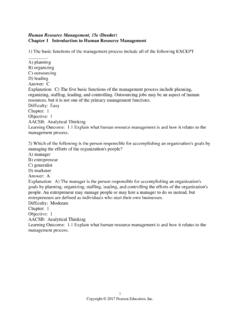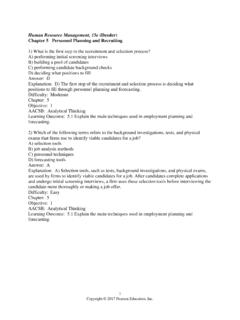Transcription of Human Resource Management, 15e (Dessler) Chapter 8 ...
1 1 Copyright 2017 Pearson Education, Inc. Human Resource management , 15e (Dessler) Chapter 8 Training and Developing Employees 1) On Alicia's first day of work at a software firm, she attended a meeting with the HR manager and other new employees. Alicia learned about employee benefits packages, personnel policies, and the structure of the company. In which of the following did Alicia most likely participate? A) recruitment B) selection C) employee orientation D) employee development Answer: C Explanation: C) Employee orientation or onboarding provides new employees with the basic background information (such as computer passwords and company rules) they need to do their jobs; ideally it should also help them start becoming emotionally attached to and engaged in the firm. Difficulty: Moderate Chapter : 8 Objective: 1 AACSB: Application of Knowledge Learning Outcome: Summarize the purpose and process of employee orientation.
2 2) Which of the following terms refers to helping new employees appreciate the values and culture of a firm? A) onboarding B) outsourcing C) organizing D) offshoring Answer: A Explanation: A) Onboarding is synonymous with employee orientation, which involves providing new employees with the information they need to function. Onboarding also tries to help new employees understand a firm's values and culture. Difficulty: Easy Chapter : 8 Objective: 1 AACSB: Analytical Thinking Learning Outcome: Summarize the purpose and process of employee orientation. 2 Copyright 2017 Pearson Education, Inc. 3) Which of the following is most likely NOT one of the goals of a firm's employee orientation program? A) making new employees feel like part of a team B) helping new employees become socialized into the firm C) assisting new employees in selecting the best labor union D) teaching new employees about the firm's history and strategies Answer: C Explanation: C) During employee orientation, firms try to make the new employee feel welcome and at home and part of the team, make sure the new employee has the basic information to function effectively, help the new employee understand the organization in a broad sense, and start the person on the process of becoming socialized into the firm's culture, values, and ways of doing things.
3 It is less likely that the firm would help employees join a labor union. Difficulty: Hard Chapter : 8 Objective: 1 AACSB: Analytical Thinking Learning Outcome: Summarize the purpose and process of employee orientation. 4) All of the following topics are typically addressed during employee orientation EXCEPT _____. A) employee benefits B) personnel policies C) work behavior expectations D) wage curves Answer: D Explanation: D) A wage curve is the graphic relationship between the value of the job and the average wage paid for the job. It is unlikely that wage curves would be addressed during Difficulty: Moderate Chapter : 8 Objective: 1 AACSB: Analytical Thinking Learning Outcome: Summarize the purpose and process of employee orientation. 5) Employee orientation programs range from brief, informal introductions to lengthy, formal courses. Answer: TRUE Explanation: The length of the employee orientation process depends on the firm and the job.
4 In some cases, onboarding-type programs may take many days, while in other cases, orientation consists of showing someone around and making introductions. Difficulty: Easy Chapter : 8 Objective: 1 AACSB: Analytical Thinking Learning Outcome: Summarize the purpose and process of employee orientation. 3 Copyright 2017 Pearson Education, Inc. 6) Hiring highly-skilled employees with great potential eliminates the need to provide orientation and training. Answer: FALSE Explanation: Having high-potential employees doesn't guarantee they'll succeed. Instead, they must know what you want them to do and how you want them to do it. If they don't, they will improvise or do nothing useful at all. Difficulty: Moderate Chapter : 8 Objective: 1 AACSB: Analytical Thinking Learning Outcome: Summarize the purpose and process of employee orientation. 7) What is the purpose of employee orientation? What role does training play in employee orientation?
5 Answer: New employees should feel welcome and at ease. New employees should understand the organization in a broad sense including its past, present, culture, and vision for the future. They should be clear about what is expected in terms of work and behavior. They should have begun the socialization process into the firm's way of doing things. Directly after orientation, training should begin. Training means giving new or current employees the skills they need to perform their jobs. Difficulty: Hard Chapter : 8 Objective: 1 AACSB: Analytical Thinking Learning Outcome: Summarize the purpose and process of employee orientation. 8) The methods used to give new or present employees the skills they need to perform their jobs are called _____. A) orientation B) training C) development D) management Answer: B Explanation: B) Training means giving new or current employees the skills they need to perform their jobs.
6 Training is essential to good management . Difficulty: Easy Chapter : 8 Objective: 3 AACSB: Analytical Thinking Learning Outcome: List and briefly explain each of the steps in the training process. 4 Copyright 2017 Pearson Education, Inc. 9) MTR Enterprises failed to provide adequate safety training to one of its employees. As a result, the employee harmed a customer. A court would most likely find MTR liable for _____. A) discrimination B) negligent training C) occupational fraud D) hazardous training Answer: B Explanation: B) Inadequate training can expose employers to negligent training liability. If an employer fails to train adequately and an employee harms a third party, it is likely that the court will find the employer liable. Difficulty: Easy Chapter : 8 Objective: 1 AACSB: Application of Knowledge Learning Outcome: List and briefly explain each of the steps in the training process. 10) Which of the following will most likely NOT help employers protect themselves against charges of negligent training?
7 A) confirming an employee's claims of skill and experience B) providing extensive and appropriate training C) evaluating the effectiveness of the training D) paying employees for their training time Answer: D Explanation: D) Employers should confirm the applicant/employee's claims of skill and experience, provide adequate training (particularly where employees use dangerous equipment), and evaluate the training to ensure that it's actually reducing risks. Paying employees for training will not necessarily protect an employer. Difficulty: Hard Chapter : 8 Objective: 3 AACSB: Analytical Thinking Learning Outcome: List and briefly explain each of the steps in the training process. 5 Copyright 2017 Pearson Education, Inc. 11) _____ identifies the training employees will need to fill future jobs. A) Competency modeling B) Performance analysis C) Strategic training needs analysis D) Screening Answer: C Explanation: C) Strategic goals (perhaps to enter new lines of business or to expand abroad) often mean the firm will have to fill new jobs.
8 Strategic training needs analysis identifies the training employees will need to fill these future jobs. Difficulty: Moderate Chapter : 8 Objective: 1 AACSB: Analytical Thinking Learning Outcome: List and briefly explain each of the steps in the training process. 12) What is the first step in the ADDIE training process? A) assessing the program's successes B) appraising the program's budget C) analyzing the training need D) acquiring training materials Answer: C Explanation: C) The gold standard of training programs is the basic analysis-design-develop-implement-evalua te (ADDIE) training process model that training experts have used for years. The first step is to analyze the training need. Difficulty: Moderate Chapter : 8 Objective: 3 AACSB: Analytical Thinking Learning Outcome: List and briefly explain each of the steps in the training process. 13) What is the second step in the ADDIE training process?
9 A) developing training aids B) defining the training objectives C) designing the overall training program D) designating employees who need training Answer: C Explanation: C) The basic analysis-design-develop-implement-evalua te (ADDIE) training process model has been used by training experts for years. The second step of the process is designing the overall training program. Difficulty: Moderate Chapter : 8 Objective: 3 AACSB: Analytical Thinking Learning Outcome: List and briefly explain each of the steps in the training process. 6 Copyright 2017 Pearson Education, Inc. 14) Which of the following will most likely occur during the third step of the ADDIE training process? A) training a targeted group B) creating training materials C) evaluating the success of the program D) estimating a budget for the training program Answer: B Explanation: B) The basic analysis-design-develop-implement-evalua te (ADDIE) training process model has been used by training experts for years.
10 The third step, developing the course, involves assembling and creating the training materials. Difficulty: Moderate Chapter : 8 Objective: 3 AACSB: Application of Knowledge Learning Outcome: List and briefly explain each of the steps in the training process. 15) Which of the following would most likely occur during the fourth step of the ADDIE training process? A) holding on-the-job training sessions B) selecting employees for training C) preparing online training materials D) asking participants for feedback Answer: A Explanation: A) The basic analysis-design-develop-implement-evalua te (ADDIE) training process model has been used by training experts for years. The fourth step involves providing the training to a targeted employee group. Training methods vary but may include on-the-job training or online training. Difficulty: Moderate Chapter : 8 Objective: 3 AACSB: Application of Knowledge Learning Outcome: List and briefly explain each of the steps in the training process.


